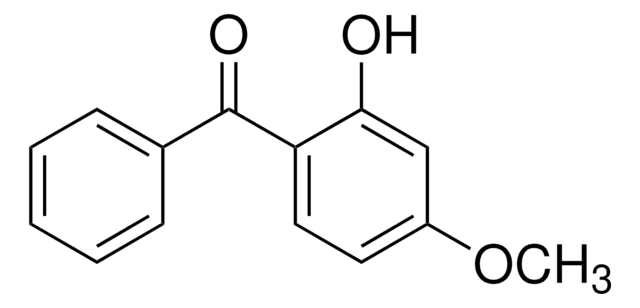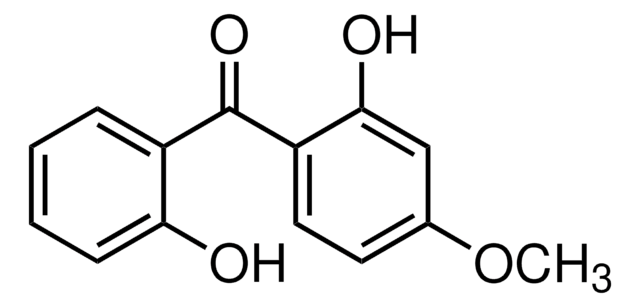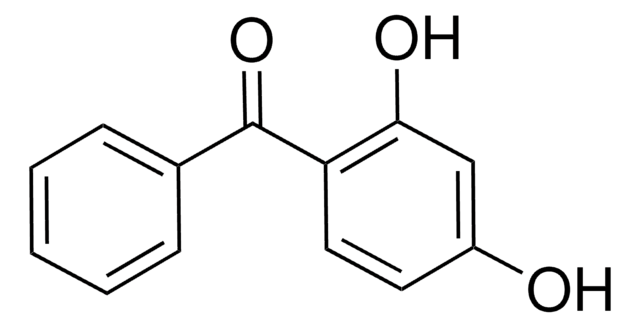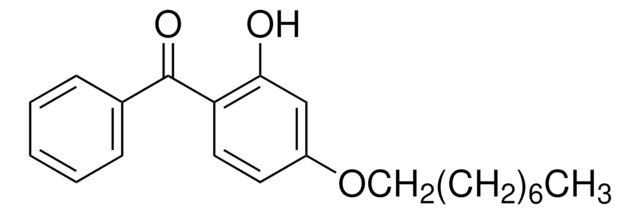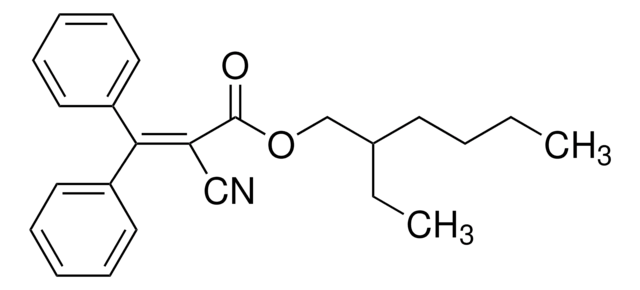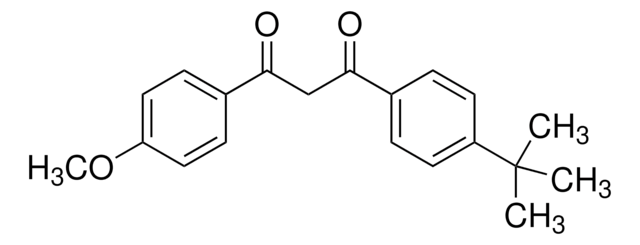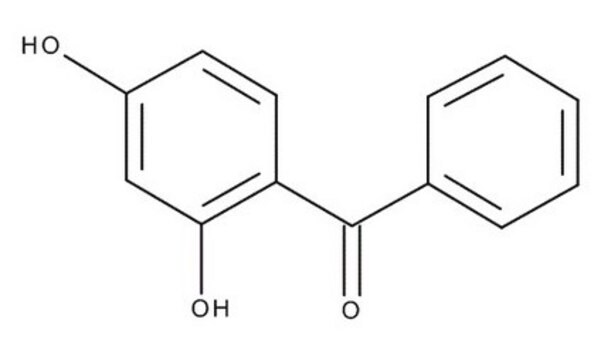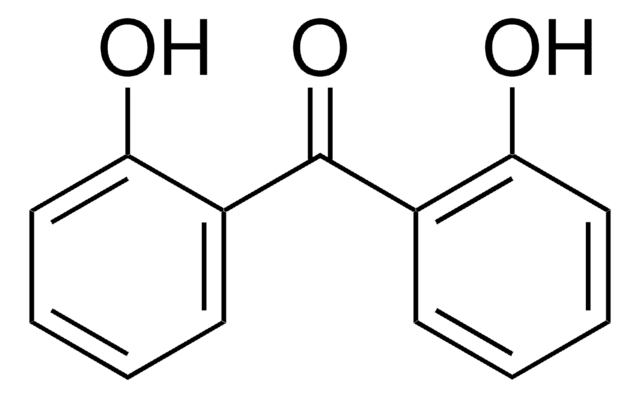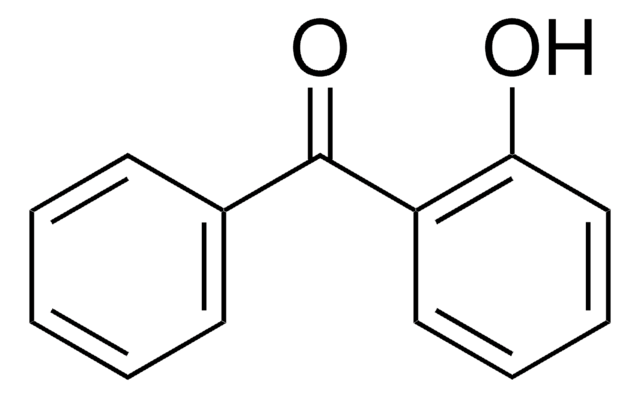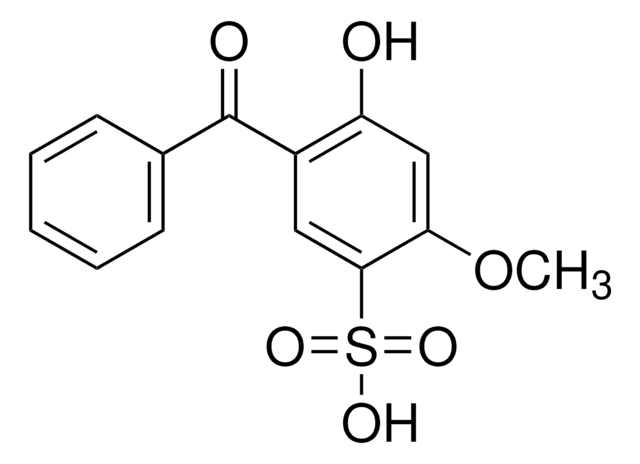Wszystkie zdjęcia(3)
Kluczowe dokumenty
T16403
2,2′,4,4′-Tetrahydroxybenzophenone
97%
Zaloguj sięWyświetlanie cen organizacyjnych i kontraktowych
About This Item
Wzór liniowy:
[(HO)2C6H3]2CO
Numer CAS:
Masa cząsteczkowa:
246.22
Numer WE:
Numer MDL:
Kod UNSPSC:
12352100
Identyfikator substancji w PubChem:
NACRES:
NA.22
Polecane produkty
Poziom jakości
Próba
97%
mp
198-200 °C (lit.)
ciąg SMILES
Oc1ccc(c(O)c1)C(=O)c2ccc(O)cc2O
InChI
1S/C13H10O5/c14-7-1-3-9(11(16)5-7)13(18)10-4-2-8(15)6-12(10)17/h1-6,14-17H
Klucz InChI
WXNRYSGJLQFHBR-UHFFFAOYSA-N
Szukasz podobnych produktów? Odwiedź Przewodnik dotyczący porównywania produktów
Powiązane kategorie
Zastosowanie
- Stężenia bisfenolu A, parabenów i filtrów światła ultrafioletowego typu benzofenonu w moczu w odniesieniu do fragmentacji DNA plemników u młodych mężczyzn: A chemical mixtures approach.: W niniejszym badaniu zbadano związek między stężeniem w moczu różnych substancji chemicznych, w tym filtrów UV typu benzofenonu, takich jak 2,2′,4,4′-tetrahydroksybenzofenon, a fragmentacją DNA plemników. Odkrycia te podkreślają potencjalne ryzyko toksyczności reprodukcyjnej związane z narażeniem na te związki (Kiwitt-Cárdenas et al., 2024).
- Ekstrakcja ciecz-ciecz wspomagana soleniem w połączeniu z LC-MS/MS do jednoczesnego oznaczania siedmiu organicznych filtrów UV w próbkach wody środowiskowej: opracowanie metody i zastosowanie...: W artykule omówiono opracowanie metody wykrywania organicznych filtrów UV, w tym 2,2′,4,4′-tetrahydroksybenzofenonu, w środowiskowych próbkach wody. Metoda ta oferuje niezawodny sposób monitorowania obecności tych związków w środowisku (Carve et al., 2023).
- Nowe trójskładnikowe fotokatalizatory α-Bi(2)O(3)/WO(3) na bazie P-g-CN z podwójną heterostrukturą Z do wydajnego rozkładu ogniotrwałych filtrów ultrafioletowych i hormonów środowiskowych: Benzofenonów: W pracy przedstawiono nowy fotokatalizator zdolny do degradacji filtrów UV typu benzofenonu, w tym 2,2′,4,4′-tetrahydroksybenzofenonu, w świetle widzialnym. Rozwój ten ma znaczące implikacje dla technologii oczyszczania środowiska (Berekute et al., 2023).
- Zwiększenie eliminacji filtrów przeciwsłonecznych, tetrahydroksybenzofenonu (BP-2), z wody przy użyciu monopersiarczanu aktywowanego przez ciernisty NanoBox z Co@C przygotowany za pomocą zmodyfikowanej strategii trawienia: Badanie porównawcze i mechanistyczne..: W niniejszym badaniu zbadano nowatorską metodę usuwania 2,2′,4,4′-tetrahydroksybenzofenonu z wody przy użyciu zaawansowanej nanotechnologii, podkreślając jej skuteczność i potencjał w zastosowaniach środowiskowych (Khiem et al., 2023).
- Mechanizm wiązania filtrów UV typu benzofenonu i albuminy surowicy ludzkiej: Rola miejsca, liczby i rodzaju podstawień grup funkcyjnych...: W badaniu zbadano, w jaki sposób filtry UV typu benzofenonu, w tym 2,2′,4,4′-tetrahydroksybenzofenon, oddziałują z albuminą surowicy ludzkiej, zapewniając wgląd w ich zachowanie w układach biologicznych i potencjalne implikacje zdrowotne (Ma et al., 2023).
Ta strona może zawierać tekst przetłumaczony maszynowo.
Hasło ostrzegawcze
Warning
Zwroty wskazujące rodzaj zagrożenia
Zwroty wskazujące środki ostrożności
Klasyfikacja zagrożeń
Acute Tox. 4 Oral - Eye Irrit. 2 - Skin Sens. 1A
Kod klasy składowania
11 - Combustible Solids
Klasa zagrożenia wodnego (WGK)
WGK 3
Temperatura zapłonu (°F)
Not applicable
Temperatura zapłonu (°C)
Not applicable
Środki ochrony indywidualnej
dust mask type N95 (US), Eyeshields, Gloves
Wybierz jedną z najnowszych wersji:
Masz już ten produkt?
Dokumenty związane z niedawno zakupionymi produktami zostały zamieszczone w Bibliotece dokumentów.
Klienci oglądali również te produkty
Christiane Schlecht et al.
Toxicology, 205(1-2), 123-130 (2004-10-02)
The estrogen receptors (ERs) are members of a super family of ligand-activated transcription factors mediating estrogenic responses. A close functional kinship was found for the structurally related estrogen receptor-related receptor1 (ERR1), a constitutively active transcription factor. The aryl hydrocarbon receptor
Dana Seidlová-Wuttke et al.
Toxicology, 213(1-2), 13-24 (2005-06-14)
The endocrine active substances BPA, DBP and BP2 have estrogenic effects in the uterus. Proc and Lin were shown to be antiandrogenic. Whether other estrogen-regulated parameters like lipids, fat metabolism and hormones are also affected by these substances is unknown.
Christiane Schlecht et al.
Archives of toxicology, 80(10), 656-661 (2006-04-06)
The tetrahydroxylated biphenyl-ketone 2,2',4,4'-tetrahydroxybenzophenone (BP2), one of twelve benzophenone-derived UV-filters, is used in cosmetic products and in packaging materials to protect these products from light induced damage. Recently published studies showed that BP2 exerts estrogenic activity; thus, it is an
Tatyana Shaw et al.
Dermatitis : contact, atopic, occupational, drug, 21(4), 185-198 (2010-07-22)
Rising use of sunscreen products has led to increased reporting of adverse reactions to sunscreens. To investigate possible photoallergic reactions in patients who identified themselves as "being allergic" to sunscreens. Patients filled out questionnaires about types of sunscreens they used
Christiane Schlecht et al.
Toxicology, 245(1-2), 11-17 (2008-02-05)
Twelve derivatives of benzophenone (BP1-BP12) are widely used as UV-screens to protect industrial products from light induced damage. There is growing public concern about industrially produced chemicals that might interfere with hormonal signalling pathways, thus having potential adverse effects on
Nasz zespół naukowców ma doświadczenie we wszystkich obszarach badań, w tym w naukach przyrodniczych, materiałoznawstwie, syntezie chemicznej, chromatografii, analityce i wielu innych dziedzinach.
Skontaktuj się z zespołem ds. pomocy technicznej